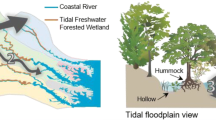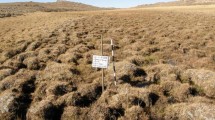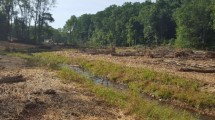Abstract
Tidal freshwater forested wetlands (TFFWs) are in an active phase of transition to tidal marsh with sea level rise and salinity incursion along the Atlantic and Gulf Coasts of the United States (U.S.). A prominent feature of TFFWs is hummock/hollow microtopography where hollows represent the flat, base-elevation of the floodplain where inundation occurs relatively frequently, while hummocks provide elevated soil surfaces that often harbor relatively greater numbers and species of trees and shrubs. Hummocks appear at the landscape river boundary just seaward of bottomland hardwoods as tides reach those positions, persist for many years, and disappear as TFFWs eventually transition to marsh. We studied TFFW surface elevation processes along four Atlantic coastal landscape river gradients by using surface elevation tables and marker horizons. Shallow subsidence between trees, equating to as much as 5.5 mm/year, was an important process in hollow maintenance as roots held hummock elevations relatively more stable. However, hummocks were actively subsiding on all sites with little sign of root zone expansion within hummocks, despite hummock elevation gain on some sites. For down-river transitions, hollow infilling through increasing sediment accretion and root zone expansion were predominant processes driving loss of microtopography as marshes replaced TFFWs closer to the estuarine interface; hollows gained elevations to meet hummocks. While these results do not preclude the importance of healthy root zone processes to the maintenance (and formation) of hummocks, our results indicate that reductions in critical sediment supplies to offset natural shallow subsidence explain persistence and eventual loss of hummock and hollow microtopography in TFFWs.








Similar content being viewed by others
Change history
25 January 2024
A Correction to this paper has been published: https://doi.org/10.1007/s12237-024-01327-w
References
Allen, S.T., and W.H. Conner. 2021. Localized augmentation of net precipitation to shrubs: a case study of stemflow funneling to hummocks in a salinity-intruded swamp. Frontiers in Forests and Global Change 4: 691321. https://doi.org/10.3389/ffgc.2021.691321.
Brinson, M.M., H.D. Bradshaw, and M.N. Jones. 1985. Transitions in forested wetlands along gradients of salinity and hydroperiod. Journal of the Elisha Mitchell Scientific Society 101: 76–94.
Cahoon, D.R., D.J. Reed, and J.W. Day Jr. 1995. Estimating shallow subsidence in microtidal salt marshes of the southeastern United States: Kay and Barghoorn revisited. Marine Geology 128: 1–9. https://doi.org/10.1016/0025-3227(95)00087-F.
Cahoon, D.R., J.C. Lynch, B.C. Perez, B. Segura, R.D. Holland, C. Stelly, G. Stephenson, and P. Hensel. 2002. High precision measurements of wetland sediment elevation: II. The rod surface elevation table. Journal of Sedimentary Research 72: 734–739. https://doi.org/10.1306/020702720734.
Callaway, J.C., D.R. Cahoon, and J.C. Lynch. 2013. The surface elevation table-marker horizon method for measuring wetland accretion and elevation dynamics. In Methods in biogeochemistry of wetlands, ed. R.D. DeLaune, et al., 901–917. Madison, Wisconsin: Soil Science Society of America. https://doi.org/10.2136/sssabookser10.c46.
Cormier, N., K.W. Krauss, and W.H. Conner. 2013. Periodicity in stem growth and litterfall in tidal freshwater forested wetlands: Influence of salinity and drought on nitrogen recycling. Estuaries and Coasts 36: 533–546. https://doi.org/10.1007/s12237-012-9505-z.
Costello, D.F. 1936. Tussock meadows in southeastern Wisconsin. Botanical Gazette 97: 610–648. https://doi.org/10.1086/334587.
Courtwright, J., and S.E.G. Findlay. 2011. Effects of microtopography on hydrology, physicochemistry, and vegetation in a tidal swamp of the Hudson River. Wetlands 31: 239–249. https://doi.org/10.1007/s13157-011-0156-9.
Craft, C.B. 2012. Tidal freshwater forest accretion does not keep pace with sea level rise. Global Change Biology 18: 3615–3623. https://doi.org/10.1111/gcb.12009.
Day, R.H., T.M. Williams, and C.M. Swarzenski. 2007. Hydrology of tidal freshwater forested wetlands of the Southeastern United States. In Ecology of Tidal Freshwater Forested Wetlands in the Southeastern United States, ed. W.H. Conner, et al., 29–63. Dordrecht, The Netherlands: Springer.
Diamond, J.S., J.M. Epstein, M.J. Cohen, D.L. McLaughlin, Y.-H. Hsueh, R.F. Keim, and J.A. Duberstein. 2020. A little relief: ecological functions and autogenesis of wetland microtopography. WIREs Water 8: e1493. https://doi.org/10.1002/wat2.1493.
Diamond, J.S., D.L. McLaughlin, R.A. Slesak, and A. Stovall. 2019. Pattern and structure of microtopography implies autogenic origins in forested wetlands. Hydrology and Earth System Sciences 23: 5069–5088. https://doi.org/10.5194/hess-23-5069-2019.
Doyle, T.W., C.P. O’Neil, M.P.V. Melder, A.S. From, and M.M. Palta. 2007. Tidal freshwater swamps of the Southeastern United States: Effects of land use, hurricanes, sea-level rise, and climate change. In Ecology of Tidal Freshwater Forested Wetlands in the Southeastern United States, ed. W.H. Conner, et al., 1–28. Dordrecht, The Netherlands: Springer.
Duberstein, J.A., and W.H. Conner. 2009. Use of hummocks and hollows by trees in tidal freshwater forested wetlands along the Savannah River. Forest Ecology and Management 258: 1613–1618. https://doi.org/10.1016/j.foreco.2009.07.018.
Duberstein, J.A., and W. Kitchens. 2007. Community composition of select areas of tidal freshwater forest along the Savannah River. In Ecology of Tidal Freshwater Forested Wetlands in the Southeastern United States, ed. W.H. Conner, et al., 321–348. Dordrecht, The Netherlands: Springer.
Duberstein, J.A., K.W. Krauss, W.H. Conner, W.C. Bridges Jr., and V.B. Shelburne. 2013. Do hummocks provide a physiological advantage to even the most flood tolerant of tidal freshwater trees? Wetlands 33: 399–408. https://doi.org/10.1007/s13157-013-0397-x.
Duberstein, J.A., W.H. Conner, and K.W. Krauss. 2014. Woody vegetation communities of tidal freshwater swamps in South Carolina, Georgia and Florida (US) with comparisons to similar systems in the US and South America. Journal of Vegetation Science 25: 848–862. https://doi.org/10.1111/jvs.12115.
Ensign, S.H., C.R. Hupp, G.B. Noe, K.W. Krauss, and C.L. Stagg. 2014. Sediment accretion in tidal freshwater forests and oligohaline marshes of the Waccamaw and Savannah Rivers. USA, Estuaries and Coasts 37: 1107–1119. https://doi.org/10.1007/s12237-013-9744-7.
Ensign, S.H., G.B. Noe, C.R. Hupp, and K.J. Skalak. 2015. Head-of-tide bottleneck of particulate material transport from watersheds to estuaries. Geophysical Research Letters 42: 10671–10679. https://doi.org/10.1002/2015GL066830.
Floyd, R.P. 1978. Geodetic bench marks, 52. Rockville, Maryland: National Oceanic and Atmospheric Administration. NOAA Manual NOS NGS 1.
From, A.S., K.W. Krauss, G.B. Noe, N. Cormier, C.L. Stagg, R.F. Moss, and J.L. Whitbeck. 2021. Belowground productivity varies by assessment technique, vegetation type, and nutrient availability in tidal freshwater forested wetlands transitioning to marsh. PLoS ONE 16: e0253554. https://doi.org/10.1371/journal.pone.0253554.
Hsueh, Y.-H., J.L. Chambers, K.W. Krauss, S.T. Allen, and R.F. Keim. 2016. Hydrologic exchanges and baldcypress water use on deltaic hummocks, Louisiana, USA. Ecohydrology 9: 1452–1463. https://doi.org/10.1002/eco.1738.
Jones, M.C., C.E. Bernhardt, K.W. Krauss, and G.B. Noe. 2017. The impact of Late Holocene land use change, climate variability, and sea level rise on carbon storage in tidal freshwater wetlands on the Southeastern United States Coastal Plain. Journal of Geophysical Research Biogeosciences 122: 3126–3141. https://doi.org/10.1002/2017JG004015.
Krauss, K.W., J.A. Duberstein, T.W. Doyle, W.H. Conner, R.H. Day, L.W. Inabinette, and J.L. Whitbeck. 2009. Site condition, structure, and growth of baldcypress along tidal/non-tidal salinity gradients. Wetlands 29: 505–519. https://doi.org/10.1672/08-77.1.
Krauss, K.W., G.B. Noe, J.A. Duberstein, W.H. Conner, C.L. Stagg, N. Cormier, M.C. Jones, C.E. Bernhardt, B.G. Lockaby, A.S. From, T.W. Doyle, R.H. Day, S.H. Ensign, K.N. Pierfelice, C.R. Hupp, A.T. Chow, and J.L. Whitbeck. 2018. The role of the upper tidal estuary in wetland blue carbon storage and flux. Global Biogeochemical Cycles 32: 817–839. https://doi.org/10.1029/2018GB005897.
Krauss, K.W., G.B. Noe, J.A. Duberstein, and A.S. From. 2023. Data to support surface elevation change and vertical accretion data to support assessment of hummock formation/loss in tidal freshwater forested wetlands along the U.S. Atlantic coast (2009–2021). U.S. Geological Survey. https://doi.org/10.5066/P91IR97H. Data release.
Kroes, D.E., C.R. Demas, Y.A. Allen, R.H. Day, S.W. Roberts, and J. Varisco. 2022. Hydrologic modification and channel evolution degrades connectivity on the Atchafalaya River floodplain. Earth Surface Processes and Landforms 47: 1790–1807. https://doi.org/10.1002/esp.5347.
Li, H., K.J. Minick, J. Luff, A. Noormets, G. Miao, B. Mitra, J.-C. Domec, G. Sun, S. McNulty, and J.S. King. 2019. Effects of microtopography on absorptive and transport fine root biomass, necromass, production, mortality and decomposition in a coastal freshwater forested wetland, Southeastern USA. Ecosystems 23: 1294–1308. https://doi.org/10.1007/s10021-019-00470-x.
Lumibao, C.Y., E.R. Kimbrough, R.H. Day, W.H. Conner, K.W. Krauss, and S. Van Bael. 2020. Divergent biotic and abiotic filtering of root endosphere and rhizosphere soil fungal communities along ecological gradients. FEMS Microbiology Ecology 96: fiaa124. https://doi.org/10.1093/femsec/fiaa124.
McDowell, N.G., M.C. Ball, B. Bond-Lamberty, M.L. Kirwan, K.W. Krauss, J.P. Megonigal, M. Mencuccini, N.D. Ward, M.N. Weintraub, and V. Bailey. 2022. Processes and mechanisms of coastal woody-plant mortality. Global Change Biology 28: 5881–5900. https://doi.org/10.1111/gcb.16297.
McKee, K.L., D.R. Cahoon, and I.C. Feller. 2007. Caribbean mangroves adjust to rising sea level through biotic controls on change in soil elevation. Global Ecology and Biogeography 16: 545–556. https://doi.org/10.1111/j.1466-8238.2007.00317.x.
Minchinton, T.E. 2001. Canopy and substratum heterogeneity influence recruitment of the mangrove Avicennia marina. Journal of Ecology 89: 888–902. https://doi.org/10.1046/j.0022-0477.2001.00599.x.
Morris, J.T., P.V. Sundareshwar, C.T. Nietch, B. Kjerfve, and D.R. Cahoon. 2002. Responses of coastal wetlands to rising sea level. Ecology 83: 2869–2877. https://doi.org/10.1890/0012-9658(2002)083[2869:ROCWTR]2.0.CO;2.
Noe, G.B., and C.R. Hupp. 2009. Retention of riverine sediment and nutrient loads by coastal plain floodplains. Ecosystems 12: 728–746. https://doi.org/10.1007/s10021-009-9253-5.
Noe, G.B., K.W. Krauss, B.G. Lockaby, W.H. Conner, and C.R. Hupp. 2013. The effect of increasing salinity and forest mortality on soil nitrogen and phosphorus mineralization in tidal freshwater forested wetlands. Biogeochemistry 114: 225–244. https://doi.org/10.1007/s10533-012-9805-1.
Noe, G.B., C.R. Hupp, C.E. Bernhardt, and K.W. Krauss. 2016. Contemporary deposition and long-term accumulation of sediment and nutrients by tidal freshwater forested wetlands impacted by sea level rise. Estuaries and Coasts 39: 1006–1019. https://doi.org/10.1007/s12237-016-0066-4.
Noe, G.B., N.A. Bourg, K.W. Krauss, J.A. Duberstein, and C.R. Hupp. 2021. Watershed and estuarine controls both influence plant community and tree growth changes in tidal freshwater forested wetlands along two U.S. Mid-Atlantic rivers. Forests 12: 1182. https://doi.org/10.3390/f12091182.
Penfound, W.T., and E.S. Hathaway. 1938. Plant communities in the marshlands of Southeast Louisiana. Ecological Monographs 8: 1–56. https://doi.org/10.2307/1943020.
Pierfelice, K.N., B.G. Lockaby, K.W. Krauss, W.H. Conner, G.B. Noe, and M.C. Ricker. 2017. Salinity influences on aboveground and belowground net primary productivity in tidal wetlands. Journal of Hydrological Engineering 22: D4015002. https://doi.org/10.1061/(ASCE)HE.1943-5584.0001223.
Rheinhardt, R.D., and C. Hershner. 1992. The relationship of below-ground hydrology to canopy composition in five tidal freshwater swamps. Wetlands 12: 208–216. https://doi.org/10.1007/BF03160611.
Riggs, S.R., and D.V. Ames. 2003. Drowning the North Carolina coast: sea-level rise and estuarine dynamics. Raleigh, North Carolina: North Carolina Sea Grant.
Rogers, K. 2021. Accommodation space as a framework for assessing the response of mangroves to relative sea-level rise. Singapore Journal of Tropical Geography 42: 163–183. https://doi.org/10.1111/sjtg.12357.
Rogers, K., J.J. Kelleway, N. Saintilan, J.P. Megonigal, J.B. Adams, J.R. Holmquist, M. Lu, L. Schile-Beers, A. Zawadzki, D. Mazumder, and C.D. Woodroffe. 2019. Wetland carbon storage controlled by millennial-scale variation in relative sea-level rise. Nature 567: 91–95. https://doi.org/10.1038/s41586-019-0951-7.
Russell, B.T., K.A. Cressman, J.P. Schmit, S. Shull, J.M. Rybczyk, and D.L. Frost. 2022. How should surface elevation table data be analyzed? A comparison of several commonly used analysis methods and one newly proposed approach. Environmental and Ecological Statistics 29: 359–391.
SAS Institute, Inc. 2018. SAS/STAT®15.1 user’s guide. Cary, NC: SAS Institute Inc.
Saintilan, N., K.E. Kovalenko, G.R. Guntenspergen, K. Rogers, J.C. Lynch, D.R. Cahoon, C.E. Lovelock, D.A. Friess, E. Ashe, K.W. Krauss, N. Cormier, T. Spencer, J. Adams, J. Raw, C. Ibañez, F.W. Scarton, S. Temmerman, P. Meire, T. Maris, K. Thorne, J. Brazner, G. Chmura, T. Bowron, V.P. Gamage, K. Cressman, C. Endris, C. Marconi, P. Marcum, K. St, W. Laurent, K.B. Reay, J.A. Garwood. Raposa, and N. Khan. 2022. Constraints on the adjustment of tidal marshes to accelerating sea level rise. Science 377: 523–527. https://doi.org/10.1126/science.abo7872.
Stagg, C.L., K.W. Krauss, D.R. Cahoon, N. Cormier, W.H. Conner, and C.M. Swarzenski. 2016. Processes contributing to resilience of coastal wetlands to sea-level rise. Ecosystems 19: 1445–1459. https://doi.org/10.1007/s10021-016-0015-x.
Stribling, J.M., J.C. Cornwell, and O.A. Glahn. 2007. Microtopography in tidal marshes: Ecosystem engineering by vegetation? Estuaries and Coasts 30: 1007–1015. https://doi.org/10.1007/BF02841391.
van Hulzen, J.B., J. van Soelen, and T.J. Bouma. 2007. Morphological variation and habitat modification are strongly correlated for the autogenic ecosystem engineer Spartina anglica (common cordgrass). Estuaries and Coasts 30: 3–11. https://doi.org/10.1007/BF02782962.
Werner, K.J., and J.B. Zedler. 2002. How sedge meadow soils, microtopography, and vegetation respond to sedimentation. Wetlands 22: 451–466. https://doi.org/10.1672/0277-5212(2002)022[0451:HSMSMA]2.0.CO;2.
Weston, N.B., R.E. Dixon, and S.B. Joye. 2006. Ramifications of increased salinity in tidal freshwater sediments: Geochemistry and microbial pathways of organic matter mineralization. Journal of Geophysical Research Biogeosciences 111: G01009. https://doi.org/10.1029/2005JG000071.
Wetzel, P.R., A. van der Valk, S. Newman, D.E. Gawlik, T. Troxler-Gann, C.A. Coronado-Molina, D.L. Childers, and F.H. Sklar. 2005. Maintaining tree islands in the Florida Everglades: Nutrient redistribution is the key. Frontiers in Ecology and the Environment 3: 370–376. https://doi.org/10.1890/1540-9295(2005)003[0370:MTIITF]2.0.CO;2.
Whelan, K.R.T., T.J. Smith III., D.R. Cahoon, J.C. Lynch, and G.H. Anderson. 2005. Groundwater control of mangrove surface elevation: Shrink and swell varies with soil depth. Estuaries 28: 833–843. https://doi.org/10.1007/BF02696013.
Acknowledgements
We acknowledge additional collaborators that informed various aspects of this project, including Camille L. Stagg, James C. Lynch, and Courtney Lee. We thank Daniel Kroes for reviewing a previous version of this manuscript. Technical Contribution No. 7114 of the Clemson University Experiment Station. This material is based upon work supported by NIFA/USDA, under project number SC-1700590. Any use of trade, firm, or product names is for descriptive purposes only and does not imply endorsement by the U.S. Government.
Funding
Funding for this research was provided by the U.S. Geological Survey Climate R&D Program. We thank Craig Sasser, Russell Webb, Lindsay Coldiron, and Chuck Hayes with the U.S. Fish and Wildlife Service for collaborating on this project for over two decades.
Author information
Authors and Affiliations
Corresponding author
Additional information
Communicated by John C. Callaway
The original online version of this article was revised: Figure 8 was corrected.
Rights and permissions
About this article
Cite this article
Krauss, K.W., Noe, G.B., Duberstein, J.A. et al. Presence of Hummock and Hollow Microtopography Reflects Shifting Balances of Shallow Subsidence and Root Zone Expansion Along Forested Wetland River Gradients. Estuaries and Coasts (2023). https://doi.org/10.1007/s12237-023-01227-5
Received:
Revised:
Accepted:
Published:
DOI: https://doi.org/10.1007/s12237-023-01227-5




